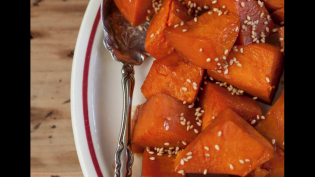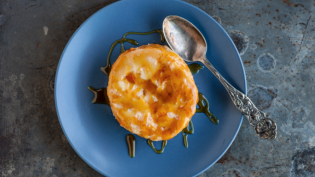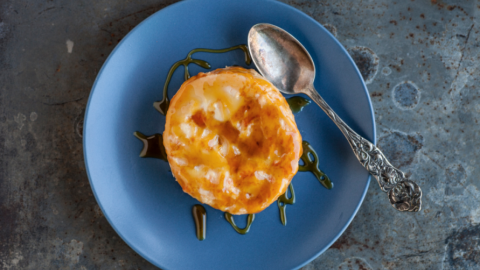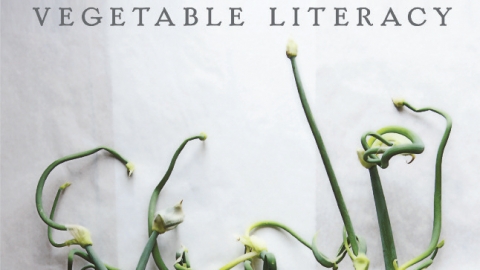You Say Yam, I Say Sweet Potato
From her forthcoming book, Vegetable Literacy
It's sweet potato time, which means it's the season when people start asking about the difference between sweet potatoes and yams, a confusion I want to address here.
Botanically sweet potatoes and yams are two different vegetables. The yam is a starchy, dry, tropical vegetable that grows in West Africa, the Caribbean and Asia. There are hundreds of varieties of yams, some very large and none especially sweet. Sweet potatoes, which grow here, are related to the morning glory. These attractive plants have deeply lobed heartshaped leaves and pale blossoms that unfold like morning glories.
The word "yam" has crept into the sweet potato nomenclature out of an old misuse of the word, but also because there are two basic kinds of sweet potatoes, those traditionally classified as "firm" (or dry) and those referred to as "soft" (or moist). These descriptors don't refer to the tubers themselves, but to the feel of the flesh once cooked. The firm types were the first to be grown in the US, so when the soft ones were introduced, growers decided to use the word "yam" to distinguish their soft sweet potatoes from the dry-fleshed firms. This probably shouldn't have happened, but it did, and the habit still persists. We have candied yams on Thanksgiving and Garnet and Jewel sweet potatoes are usually called yams in the supermarket.
Sweet potatoes are smallish tubers with pointy ends, but the colors of their skin and flesh vary wildly. The skins can be reddish brown or reddish orange, rust colored, deep purple, coppery or cream colored. The flesh ranges from that appetizing rich orange, to straw colored, grayish and lilac, to deep purple and pale yellow. I'd love to be able to walk into a market and see the full spectrum of colors, shapes and sizes. I'd try every one. In fact, that's what I've done in my own (farmers') market research–bought every variety possible, penned its name on the skin for identity, then cooked and compared one to another. Sadly, we mostly see but two or three varieties and only the soft kinds, but I mention other types in case you stumble across them in your travels, which could include Latin and Asian markets as well as farmers' markets.
In general, Asians and East Indians favor the dry varieties. As they resemble chestnuts, their cooked flesh can be used where chestnut purées are called for. Being nuttier and less sugary than the moist varieties, I find the dries more versatile: good in a salad, compatible with curry spices, happy to be glazed with honey, ginger and soy sauce, transformed into velvety custards or sweet potato pies but also delicious roasted and eaten with butter. In Japan I've encountered vendors selling hot, roasted sweet potatoes as a snack. These dryfleshed tubers can be found in Asian and Latin markets and sometimes in farmers markets.
In contrast, the soft varieties are intensely sweet. Although described as a vegetable they are, essentially, ready-made desserts. You can simply drizzle molasses and cream into their mashed flesh, or turn them into a luscious winter puddings and pies. If making candied sweet potatoes for Thanksgiving, use different varieties, slice them lengthwise and layer them so you can enjoy their different shades of orange. Their natural sweetness, when not enhanced, can be tempered by being paired with such seasonings as horseradish, ginger, cumin, curry spices of all kinds, coconut milk, coriander, chile and so forth. If you fry leftoversweet potatoes in a little butter or roasted sesame oil, their sugars will caramelize and balance their sweetness.
Regardless of whether you choose dry or moist varieties, boost their sugars or push them back with spice, sweet potatoes are an extremely versatile tuber, and a delicious one, too.
SWEET POTATO ESSENTIALS
Although they look tough and durable sweet potatoes are thin skinned and not great keepers so don't buy more than you'll eat in a week or two.
As for cooking, baking is a time-honored method. Scrub them, skip any wrappings and bake in a 375º oven until utterly yielding when pierced with a knife, an hour or more, depending on the size. If you want a sweet potato for supper and don't want to wait that long, pressure cook for about 25 minutes. After a fast release of the pressure, check to make sure they're soft. If not, return the lid and cook another 5 minutes. You can also steam them, either whole or cut into chunks, and you can boil them, although I never like the idea of diluting their flavor. As for the microwave, I don't have one, but I trust Elizabeth Schneider, author of Uncommon Fruits and Vegetables, when she says that the microwave will utterly compromise the flavor and texture of these tubers, so don't even think about it.
SWEET POTATO VARIETIES
Dry Fleshed (Firm) Sweet Potatoes
BONIATO: A Cuban sweet potato that's short and plump, with reddish skin and white flesh. The least sweet of the sweet potatoes, the skin forms a delectable crust when baked. Look for them in Latin markets.
KOTOBUKI: A long, golden skinned tuber with dry, straw colored, nutty tasting flesh.
HANNA: Short, stubby tubers with pointy ends, slightly darker skin and golden flesh; the chestnut flavor is especially rich.
OKINAWA: These sweet potatoes are generally small and not too attractive with their grayish skin. Their flesh, however, is a gorgeous magenta and the flavor rich and sweet. (Try it as a base for ice cream.) Sometimes called Hawaiian sweet potatoes.
YELLOW JERSEY: Grown in the mid-Atlantic states, these have orange skins and dry, sweet, yellow flesh.
.....
Moist (Soft) Sweet Potatoes
GARNET: Deep purple skin, dark orange flesh, very sweet, well-balanced flavor. Grown in California, Garnet is usually available in supermarkets.
DIANA: Purple skin, orange flesh, moist and extremely (if not painfully) sweet. Diana was developed to replace the Garnet because of shipping and storage problems due to the Garnet's thin skin, but the Garnet has persisted.
JEWEL: Another sweet, super-moist orange-fleshed sweet potato with a coppery, rather than red-orange skin. The Jewel, which accounts for 75% of all the commercially produced varieties, can be held for up to 50 weeks, which explains why it's nearly always available.
BEAUREGARD: Similar to Jewel, with purple-rose skin and orange flesh, it matures early, but sweetens only after two months in storage. A grower told me that it was developed to replace the Jewel because packers don't care for the way the eyes line up in a row, like a perforation.













